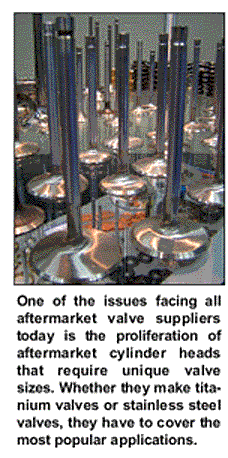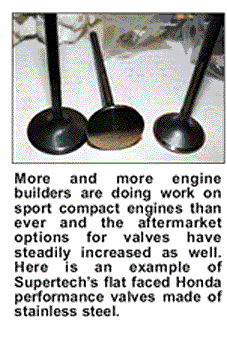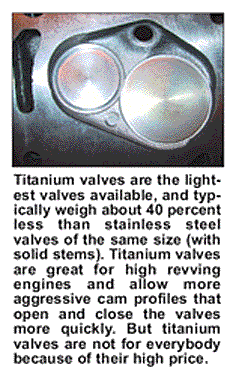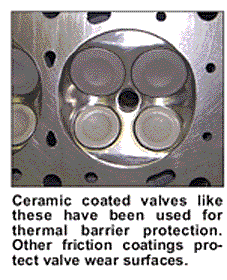The power that an engine produces depends to a large extent on how much air it flows. The larger the engine’s displacement in cubic inches, the more air it pumps with every stroke and the more horsepower it makes. Rpms also make power. In theory, doubling the engine’s speed doubles its power output. Rev an engine that produces 400 horsepower at 4,500 rpm to 9,000 rpm, and you should see 800 horsepower at the flywheel.
This sounds great, but in the real world engines don’t breathe with 100 percent efficiency as rpms increase. The twists and turns of the intake manifold, the shape and volume of the intake and exhaust ports in the cylinder head, the obstructions and turbulence created by the valve stems in the ports, the contour of the valve head and seat angles, and the shape and size of the combustion chamber all affect air flow as rpms increase.
Volumetric efficiency is a term that is used to describe the relationship between how much air an engine can theoretically flow and how much air it really flows. Modifications that increase volumetric efficiency at higher engine speeds make more horsepower. This includes all the traditional performance tricks such as porting the cylinder heads, increasing valve lift and duration with a hotter camshaft, using a larger carburetor or multiple carburetors that flow more cubic feet of air per minute (CFM), or even going to a forced induction system (turbocharger or supercharger) that pushes more air through the system than atmospheric pressure can provide.

The valves play a critical role in all of this because the valves are the choke point past which all the air that flows in and out of the engine must circumnavigate. Valves that increase air flow and allow the engine to rev higher will increase volumetric efficiency and horsepower.
Another advantage of using valves with smaller diameter stems is reduced weight. A valve with an undersized stem typically weighs about 8 to 10 percent less than one with a standard-sized stem. A lighter valve means the engine can rev higher, pump more air and produce more horsepower. A lighter valve also means less stress on the valve springs, retainers, rocker arms, pushrods, lifters and cam lobes.
Intake valves are usually heavier than exhaust valves because of their larger head diameter. Consequently, the weight of the intake valves is more of a limiting factor on the rpm potential of the engine than the exhaust valves. Even a few grams less weight can make a lot of difference in an engine that’s running at 8,500 to 9,000 rpm.
One way valve suppliers are taking additional weight out of intake (and exhaust) valves today is offering “hollow stem” valves. The valve stem is gun-drilled and micropolished to make it hollow like a pushrod. The drilling is only done in the upper 2/3 of the stem where rigidity is less of a factor than the area just above the valve head. After the stem has been drilled out, a hardened tip is welded onto the top of the stem. The result is a valve that is 20 to 22 percent lighter than a valve with a solid stem.
According to one supplier of hollow stem performance valves, the valves are good for 300 to 350 more rpm with no other modifications (same springs, rockers, pushrods, etc.).
Drilling out the valve stem to lighten the valve obviously sacrifices some strength, so a slightly stronger valve alloy may be used to maintain the same strength as before. One supplier of hollow stem performance valves said the durability of hollow stem valves is not an issue in naturally aspirated performance engines. But he did not recommend using hollow stem valves in turbocharged or supercharged engines, or in engines using nitrous oxide because of the increased heat.
Sodium-filled hollow stem valves are available for higher heat applications, and are typically used for the exhaust valves. The sodium inside the valve stem melts and absorbs heat from the valve heat. As the valve opens and closes, the sodium sloshes up and down inside the valve to transfer heat from the valve head to the stem. This helps the head run cooler to reduce the risk of valve burning, preignition and detonation. The difference in cooling is quite dramatic. With a conventional solid stem exhaust valve, 75 percent of the cooling takes place across the valve seat and 25 percent through the stem. In a sodium-filled exhaust valve, 40 percent of the cooling is through the stem so the valve can tolerate more heat.
TITANIUM VALVES
Titanium valves are the lightest valves available, and typically weigh about 40 percent less than stainless steel valves of the same size (with solid stems). Titanium valves are great for high revving engines and allow more aggressive cam profiles that open and close the valves more quickly. But titanium valves are not for everybody because of their high price. Titanium valves may cost $80 to $85 each, and a set of custom-made titanium valves may be $90 to $100 for each one.
Because titanium valves are so expensive (due to rising material costs), many titanium valves are custom machined rather than produced to stock dimensions for specific heads. The head diameter, stem length and diameter, and tip are all machined to the engine builders’ specifications. This allows engine builders to get exactly what they want, and eliminates the need for suppliers to produce and stock inventory for applications that may or may not sell well.
One of the issues facing all aftermarket valve suppliers today is the proliferation of aftermarket cylinder heads that require unique valve sizes. Whether they make titanium valves or stainless steel valves, they have to cover the most popular applications – which includes a growing number of aftermarket performance heads from Brodix, Dart, Edelbrock, World and others. Most of the street performance heads use the same sized valves as OEM heads, but many racing heads do not. The head may require a valve that is slightly longer than a standard Chevy SB or BB valve, or one with a different head or stem diameter. As a result, valve suppliers now have to carry a greater variety of valve head and stem diameters, and lengths – or custom make the valves on demand. Some valve suppliers say they can turn around a custom order in a week thanks to CNC tooling that allows blanks to be easily machined to specifications.
A common alloy used for titanium valves is 6242, an alloy that contains 6 percent aluminum, 2 percent moly, 4 percent zirconium and 2 percent tin. Different heat treatments are typically used for the intake valves and exhaust valves. The heat treatment is very important because it determines the ultimate strength and hardness of the metal.

Titanium valve tips and stems are often coated, especially on street applications, to improve lubricity and reduce the risk of stem galling. A steel insert may also be welded or pressed into the tip of the valve to reduce wear, or a hardened steel cap may be used on the end of the valve. Stem coatings may be plasma spray moly or a similar friction-reducing material, or a thin film coating such as diamond-like carbon (DLC), titanium nitride (TiN), or chromium nitride (CrN) applied by a physical or chemical vapor deposition process. Thin film coatings are lighter than sprayed coatings by up to 4 grams, and do not change tolerances as much. Hard thin film coatings such as diamond-like carbon are only 20 microns thick, yet are extremely durable.
In 2007, NASCAR rule changes will require the use of unleaded gasoline instead of the leaded gasoline that has been used. This will probably require the use of thin film coatings on the valve stems and seats to prevent wear.

One valve supplier we interviewed said some NASCAR engine builders are now using an “isotropic” treatment process on their titanium valves. The valves are placed in a vibratory machine filled with ceramic pellets and liquid. When the machine is turned on, the oddly-shaped ceramic pellets scrub and polish the surface of the valves, producing a non-directional surface finish that is reportedly free from microscopic peaks and stress risers. The treatment, which takes about 10 hours, reduces friction, helps the valves run up to 20 percent cooler and improves durability. It also works great on gears and similar parts.
As great as titanium is, there are some tradeoffs with this particular metal. Titanium valves do not shed heat as quickly as stainless steel valves, so the valves tend to run hotter. So many engine builders use beryllium copper valve seats with titanium valves (both intake and exhaust). Beryllium copper seats have a yellow or gold appearance, and typically contain about 2 percent beryllium (though some alloys contain only 0.2 to 0.6 percent beryllium).
The alloy conducts heat better than steel alloys or cast iron, tensile strength similar to cast iron, and is much kinder to titanium valves than hard steel seats. But beryllium is a toxic metal, so care must be used to avoid inhaling any dust when machining the seats.
Other seat materials that work with titanium include cast or sintered iron alloys for intake valves and nickel-steel alloys for the exhaust valves. For intake guides, manganese or silicon bronze are often recommended.
VALVE ALLOYS
Most of the valve supplies we interviewed for this story said stainless steel valves made of 21-2N or 21-4N continue to be their most popular alloys for street, dirt track and drag racing engines. Both are austenitic stainless steel alloys that can handle high temperatures. 21-2N stainless steel contains 21 percent chromium and 2 percent nickel. 21-4N has the same chromium content but contains almost twice as much nickel (3.75 percent), making it a more expensive alloy. 21-4N is usually considered to be the premium material for performance exhaust valves and can handle temperatures up to 1,600 degrees F. 21-4N steel also meets the “EV8” Society of Automotive Engineers (SAE) specification for exhaust valves.
SAE classifies valve alloys with a code system: “NV” is the prefix code for a low-alloy intake valve, “HNV” is a high alloy intake valve material, “EV” is an austenitic exhaust valve alloy, and “HEV” is a high-strength exhaust valve alloy.
One of the advantages of using a higher grade of stainless such as 21-4N or a similar high grade stainless alloy is that the margin on the valve head can be made thinner with less danger of cracking or burning.
For more demanding applications (engines with nitrous oxide, turbochargers or superchargers), higher temperature alloys such as inconel or similar materials may be required. Inconel is a “superalloy” material that is sometimes used for exhaust valves because of its superior high temperature strength. Inconel is a nickel base alloy with 15 to 16 percent chromium and 2.4 to 3.0 percent titanium. Inconel 751 is classified as an HEV3 alloy by SAE.

Stainless steel valves are typically chrome plated to improve lubricity and reduce stem wear, and the valve head is often swirl polished to improve airflow and reduce stress that could cause valve failure. On chrome-plated valves, the coating may be .0002″ to .0007″ thick up to a hard plating of as much as .001″.
Chrome has microscopic pores that retain oil, but actually creates a slightly rougher surface finish on the valve stem. Other alternatives include various thin film coatings for wear resistance and lubricity. Dry film coatings may also be applied to the head and valve stem to reduce the build up of carbon deposits on the valves, and ceramic thermal barrier coatings may be used on the valve face to reflect heat back into the combustion chamber.
When it comes to choosing valve alloys, the best advice is to work with your valve suppliers. They can help you decide which alloy will provide the best value and durability for the type of engine you are building. There’s no need to buy an expensive inconel or other super alloy valve if a conventional 21-2N or 21-4N has more than enough strength for the temperatures the engine will likely produce. On the other hand, if you’re building a turbocharged, supercharged or nitrous engine, you may want to upgrade to a higher temperature alloy for added protection.
The same advice applies to choosing lighter valves such as hollow stem valves or titanium valves. For a low rpm torquer engine that will never see the high side of 5,500 rpm, lighter valves would probably be a waste of money. But on a high revving engine, lighter is always better in terms of performance and durability. Today’s hollow stem stainless steel valves provide half the weight savings of titanium valves at much less cost, and they do not require any changes in the valve seats. For many racers, hollow stem valves provide the best combination of weight savings, durability and cost.













